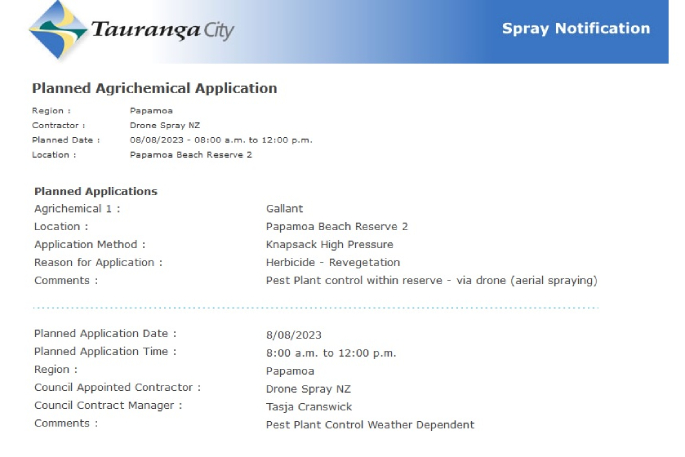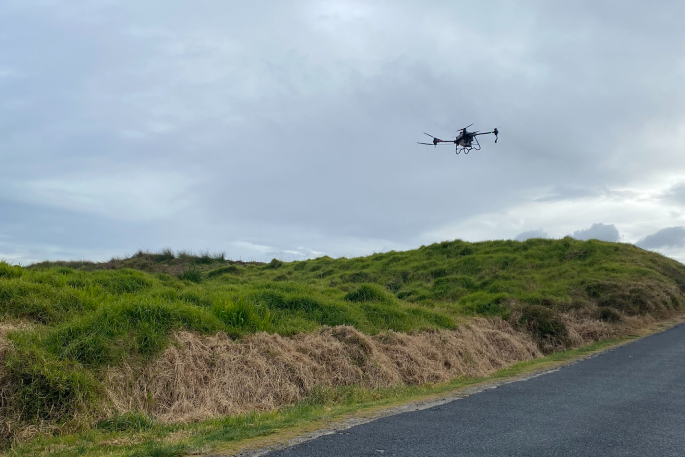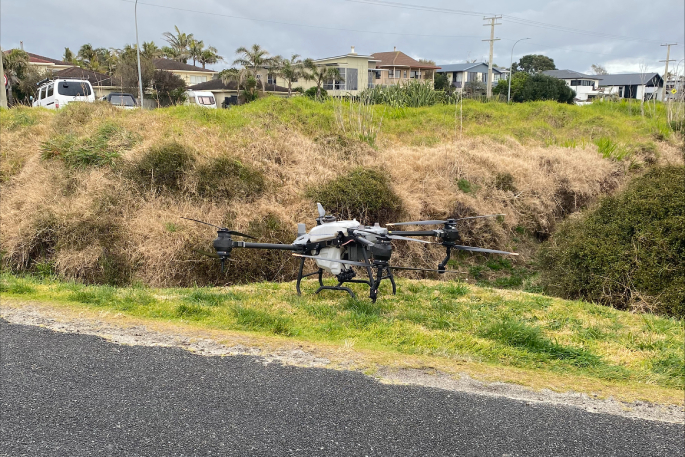An aerial drone being used for spraying in the Pāpāmoa sand dunes has raised a concern from a resident.
“I went down to my local shop and found a notification there of drone sprayings in the Pāpāmoa sand dunes near the Pāpāmoa east boat ramp by the reserve,” says the resident.
“It was a low wind day and they put up signage on the access way through the sand dunes, however, the spraying started at 6am and was to go until 5pm.”
She says she saw a woman with a pushchair and toddler and two dogs going for a walk in the area around 9am, and was concerned that the mother would have been unaware of the drone spraying.
“They were spraying at 6am so this means all the local children walking to school were possibly in danger of coating from the westerly breeze.”
She checked the Tauranga City Council website and saw there was a notification for aerial drone spraying in the sand dunes for weed control.
“I called Tauranga City Council and they said they don’t use drones to spray. Even though it’s on their website that a contractor was using drones to spray. I saw the drone, it’s massive.”
An allergy sufferer, she believes that previous spraying in early June on Tara Road may have been the cause of her becoming unwell.
“It was a very windy day and I got sick for two months.”
 The notification on the Tauranga City Council website of drones being used for weed spraying in the Pāpāmoa sand dunes. Photo: Supplied.
The notification on the Tauranga City Council website of drones being used for weed spraying in the Pāpāmoa sand dunes. Photo: Supplied.
Tauranga City Council has confirmed that aerial drone spraying was undertaken at the Taylor Road end of Pāpāmoa Beach Reserve 2 on Tuesday, August 8, between 8am and 12pm, and only within the reserve area.
“It’s the first time TCC has used a drone equipped with a 40L knapsack,” says Tauranga City Council natural environment advisor Tasja Cranswick.
“The spraying was for pest plant control and is the beginning of our restoration of the Pāpāmoa dunes.”
A letter drop was completed by council in the nearby area on Monday, July 31, to advise residents of the spraying activity and the access way being affected.
“Along with letter drops, we update our webpage (https://www.tauranga.govt.nz/council/council-news-and-updates/agrichemical-applications) and install agrichemical notification signage in the nearby area, such as the reserve access ways for Tuesday’s spraying.”
The planned agrichemical application was weather dependent, however it turned out to be a relatively low wind day with an average westerly wind speed of around 7-19 km/h with spots of rain forecast.
Tasja says the chemical being used is herbicide commonly referred to as Gallant, and Haloxyfop is an active ingredient in it. Gallant is a well-known grassweed herbicide.
“This is an approved herbicide which we frequently use to protect native plants on the dunes.
“This does have a distinct smell to it which can cause people to think they have been sprayed due to the smell.”
Tasja says council contractors use blue dye within the spray so people can clearly see where an area has been sprayed.
“There is minimal risk or danger to residents and there is no adverse impact compared to other methods of spraying that occurs in the reserve. There are few people with severe chemical sensitivity in the area, and most have registered to our agrichemical spray notification system.
 The drone being used for weed spraying in the Pāpāmoa sand dunes. Photo: Supplied.
The drone being used for weed spraying in the Pāpāmoa sand dunes. Photo: Supplied.
Previous herbicide spraying techniques utilised knapsacks and spot guns.
“Practices and technology change to be more effective and efficient,” says Tasja.
“Using a drone for spraying is faster, more accurate, less invasive, and cheaper. The drone is controlled by a registered and licenced operator who is equipped with a camera to stop if needed for anyone who accidentally enters the spray area or ignores the signage.”
Anyone with concerns about spraying in their area can receive agrichemical spray notifications from council by registering here: www.tauranga.govt.nz/council/council-news-and-updates/agrichemical-applications



2 comments
Kikuyu?
Posted on 17-08-2023 12:45 | By SonnyJim
If the council is spraying for Kikuyu, then great; but it got there from residential lawns in the old days when Kikuyu lawn clippings were regularly dumped 'across the road'. Kikuyu left to grow as a wilding forms a very thick mat of dry undergrowth that when caught alight burns as if petrol were thrown upon it. Home lawns will also burn well if not kept short.
Very cool
Posted on 17-08-2023 18:24 | By Informed
Great use of technology to deliver better outcomes.
Leave a Comment
You must be logged in to make a comment.